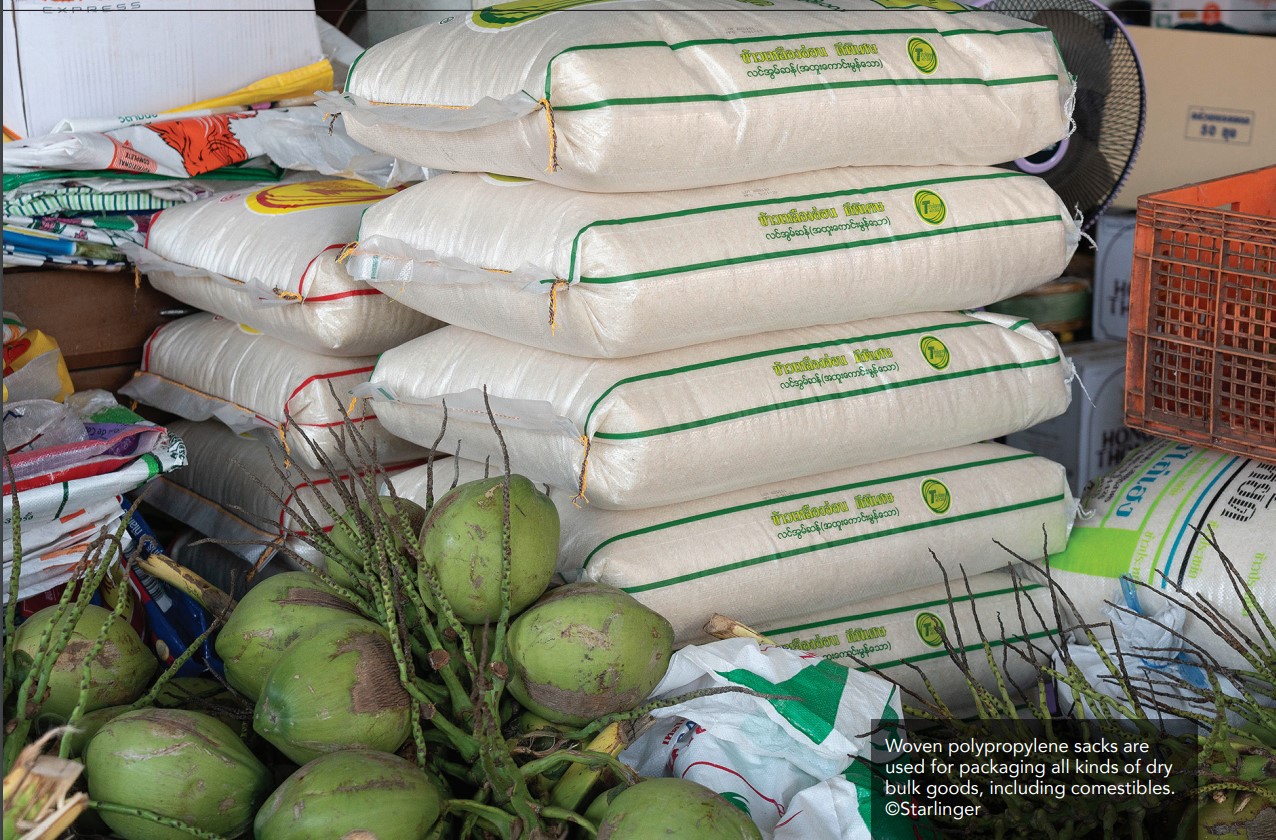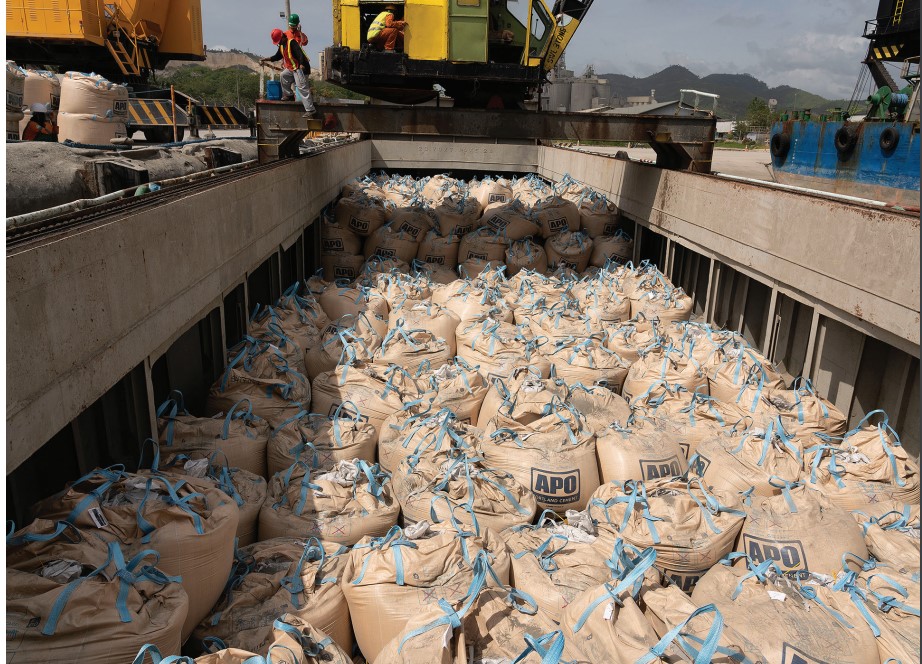Recycled and Recyclable: The Woven Plastic Bag of the Future
- Published: February 06, 2023
By Sigrid Eder-Ince, Starlinger & Co GmbH
 The circular economy for plastic packaging is on its way: Countries worldwide are adopting measures to reduce or ban single-use plastic packaging and promoting recycled content in and recyclability of the packaging. This also affects woven plastic sacks, a widely used packaging for transporting and storing dry bulk goods. This article looks at some examples of legislative measures for more circularity in plastic packaging and discusses solutions for woven plastic packaging to meet the proposed targets.
The circular economy for plastic packaging is on its way: Countries worldwide are adopting measures to reduce or ban single-use plastic packaging and promoting recycled content in and recyclability of the packaging. This also affects woven plastic sacks, a widely used packaging for transporting and storing dry bulk goods. This article looks at some examples of legislative measures for more circularity in plastic packaging and discusses solutions for woven plastic packaging to meet the proposed targets.
Governments in a number of countries are introducing legislative measures to make plastic packaging more sustainable. The EU Plastic Packaging Levy, the UK Plastic Packaging Tax or directives proposed by organizations such as the Global Plastics Pact by the Ellen McArthur Foundation, all target the plastic packaging industry.
The goals of such legislative measures are to provide an economic incentive for businesses to use recycled material in plastic packaging, to create greater demand for recycled materials, and to increase levels of collection and recycling of plastic waste to divert streams from landfill or incineration.
EU Plastics Strategy
The EU plastics strategy was launched in 2018 and defines, among others, the following goals:
- Currently, 25 percent of all plastic waste must be recycled;
- 50 percent of all plastic waste must be recycled by 2025;
- 55 percent of all plastic waste must be recycled by 2030; and
- all plastics packaging placed on the EU market must be either reusable or recyclable by 2030.1
In addition, EU member states have to pay a “plastic levy” of EUR 800 ($850 U.S.) per ton of plastic waste that is not recycled since January 2021.2 Regarding recycled content in plastic packaging, however, no prescribed amounts have been defined yet.
Taxing Plastic Packaging
Independently of the EU Plastics Strategy, countries such as the UK, Spain and Italy have, or are about to introduce, national taxes for plastic packaging. They apply to plastic packaging placed on the markets of these countries, including imports.
In the UK, a plastic packaging tax of GBP 200 ($243 U.S.) per ton took effect on April 1, 20223. It applies to all plastic packaging manufactured in or imported into the UK that does not contain at least 30 percent recycled plastic. Imported plastic packaging is liable to the tax, whether the packaging is unfilled of filled. The tax affects UK manufacturers as well as importers of plastic packaging as soon as they handle more than 10 tons of plastic packaging. The tax does not apply to plastic packaging that has more than 30 percent recycled content, or packaging that is not predominately plastic by weight.4
Spain and Italy, on the other hand, are planning to impose a tax on single-use plastics. It focuses on the manufacture, import and intra-community acquisition of non-reusable plastic packaging and will affect producers and importers of plastic packaging in the respective countries. A fee of EUR 450 ($478 U.S.) per ton will apply to all types of single-use plastic packaging used for goods and foodstuffs. In contrast to the UK plastic packaging tax, there is no threshold of recycled content to determine the taxability of the product. In both countries, the legislation went into effect on January 1, 2023.5 6
But not only European countries are taking measures to reduce plastic waste contaminating the environment and to foster recycling rates. Leading economies like the U.S. and China are also introducing legislation or applying directives set up by trade organizations to increase the use of recycled materials and the collection and recycling rates of plastic waste.
Roadmap to More Sustainability in China
The China National Resource Recycling Association (CRRA) and the National development and Reform Commission (NDRC) have set up standards and a roadmap to encourage corporates to improve recycling facilities, use clean production technologies and green designs to contribute to a circular economy by 2025. The measures also target the plastics and packaging sector, e.g. with a nationwide ban of single-use and non-degradable plastics that went into effect in major cities in 2020 and the rest of the country at the beginning of 2022.7
The Group Standard released by CRRA in January 2021 defines guidelines for the easy-to-collect and easy-to-recycle design of plastic products. Plastic manufacturers are expected to comply with the standard to help increase the collection and recycling rate of waste plastic in China.8
The measures mentioned above are part of China’s 14th Five-Year plan (2021-2025) to cut carbon emissions, consolidate industry structures and boost energy efficiency. Industrials will face higher regulatory pressure to meet sustainability goals. The regulations will also be a key driver of investments in advanced technology to improve efficiency, green product design and recycling infrastructure.9
NGOs and Industry Associations Drive Circular Economy in the U.S.
 The U.S. Plastics Pact is part of the Ellen MacArthur Foundation’s (EMF) Global Plastics Pact network and aims to create a platform for industry-led innovation and a unified national framework for a circular economy for plastics.
The U.S. Plastics Pact is part of the Ellen MacArthur Foundation’s (EMF) Global Plastics Pact network and aims to create a platform for industry-led innovation and a unified national framework for a circular economy for plastics.
Market-leading members of the EMF such as Johnson & Johnson, Mondi, Heineken and Henkel AG have joined the Foundation’s New Plastics Economy Initiative and have become powerful industry trendsetters on the road toward a circular economy for plastics.
The roadmap defined by the US Plastics Pact includes four targets:
- The definition of a list of unnecessary or problematic packaging by 2021 and elimination of it by 2025;
- to make 100 percent of plastic packaging reusable, recyclable or compostable by 2025;
- to undertake ambitious actions to effectively recycle or compost 50 percent of plastic packaging by 2025;
- and to include an average of 30 percent recycled or responsibly-sourced bio-based content by 2025.10
The American Chemistry Council (ACC), too, proposed an Action Plan for a circular economy,11 and the first law on recycled content for plastic packaging in the U.S. went into force at the beginning of January 2022 in the East-Coast State of New Jersey.12
Recycled Polypropylene in Woven Sacks and Big Bags
With billions of woven sacks and big bags being produced worldwide every year, the potential to save resources through the use of recycled material is enormous. In the past years, there have been successful efforts in the industry to develop processes for using recycled polypropylene in tape production for woven sacks and big bags without cutting back on quality.
As polypropylene degrades in the recycling process, the high requirements for polypropylene tape production call for best recyclate quality to guarantee safe usage and handling of the woven packaging produced. The recycled polypropylene is added in the tape extrusion process – shares of 50 percent rPP and more are possible.
With the correct recyclate quality, the properties (e.g. tensile strength, weight and, in case of big bags, safety factor) of woven sacks with rPP content are the same as with virgin material and have been tested using standard testing procedures and certified equipment.
The Ultimate Goal: Woven Sacks Made of up to 100 Percent Recycled Material
An alternative for woven sack producers is tape fabric made from PET. Besides its high strength and form stability, which makes PET fabric perfect also for heavy-duty applications such as big bags, PET can be recycled and refined so that its properties are the same as those of virgin material.
With a method called solid-state polycondensation (SSP), the molecular weight of recycled PET can be restored to its original level, thereby yielding material that is literally “as good as new,” even after having been recycled many times. This means that with PET, the recycled content of woven sacks and big bags can even be up to 100 percent.
In addition, the food-grade quality of rPET produced with FDA- and EFSA-approved PET recycling and decontamination processes also opens up multiple possibilities for food-contact packaging, enabling woven sack and big bag manufacturers to broaden their customer base.
Conclusion
The legislative measures outlined before clearly indicate the worldwide trend toward a circular economy for plastic packaging, and this trend will also affect producers of woven plastic sacks and big bags. Within the next years, these types of plastic packaging, together with many others, will have to be either reusable, have a certain content of recycled material, or be recyclable. If not, they might be taxed and lose competitiveness by becoming more expensive.
Design for Recycling (DfR) will play a significant role: Woven plastic sacks and big bags will have to be “easy-to-recycle,” i.e. a mono-material packaging without too many dispensable additives such as color or printing. Solutions to produce woven sacks and big bags with recycled content that meet the highest quality standards are already available on the market.
1 EU rules on packaging and packaging waste, including design and waste management, European Commission, viewed on 13 December 2022, https://environment.ec.europa.eu/topics/waste-and-recycling/packaging-waste_en
2 Plastics own resource, European Commission, viewed 26 January 2022, https://ec.europa.eu/info/strategy/eu-budget/long-term-eu-budget/2021-2027/revenue/own-resources/plastics-own-resource_en
3 Introduction of Plastic Packaging Tax from April 2022, 2021, HM Revenue & Customs, viewed on 13 December 2022, https://www.gov.uk/government/publications/introduction-of-plastic-packaging-tax-from-april-2022/introduction-of-plastic-packaging-tax-2021
4 Are you Plastic Tax Ready?, 2022, Wastepack Ltd., viewed 07 December 2022, https://www.wastepack.co.uk/plastic-packaging-tax/
5 Spain: New indirect tax on non-reusable plastic packaging starting 1 January 2023, Global VAT Compliance, viewed on 15 December 2022, https://www.globalvatcompliance.com/globalvatnews/spain-new-indirect-tax/
6 Italy’s plastic tax will enter into force on 1 January 2023, 2022, EY Global, viewed 15 December 2022, https://www.ey.com/en_gl/tax-alerts/italy-splastic-tax-will-enter-into-force-on-1-january-2023
7 China: Single-Use Plastic Straw and Bag Ban Takes Effect, 2021, Library of Congress, viewed 12 December, https://www.loc.gov/item/global-legal-monitor/2021-03-23/china-single-use-plastic-straw-and-bag-bantakes-effect/
8 Yan, C. China establishes guidelines for assessing easy-to-collect & easy-to-recycle design of plastic products, 2021, Enviliance ASIA, viewed 12 December 2022, https://enviliance.com/regions/east-asia/cn/report_2258
9 China’s Circular-Economy Push Addresses Waste Reduction and Overcapacity, 2021, FitchRatings, viewed 12 December 2022, https://www.fitchratings.com/research/corporate-finance/china-circular-economy-push-addresses-waste-reduction-overcapacity-17-08-2021
10 U.S. Plastics Pact – Our 2025 Targets, U.S. Plastics Pact, viewed 13 December 2022, https://usplasticspact.org/take-action/
11 Circular Economy for Plastics Essential to a More Sustainable Future, 2021, American Chemistry Council, viewed 13 December 2022, https://www.americanchemistry.com/chemistry-in-america/news-trends/press-release/2021/circular-economy-for-plastics-essential-to-a-more-sustainable-future
12 Enck, J. Gov. Murphy Signs Recycled Content for Plastics Bill into Law, 2022, Beyond Plastics, viewed 13 December 2022, https://www.beyondplastics.org/press-releases/nj-gov-signs-recycled-plastic-content-bill
About the Author
Sigrid Eder-Ince handles public relations for Austrian machinery producer Starlinger & Co GmbH. She holds a degree in Translation Sciences and worked as a technical translator for many years, when she built up her technical knowledge in plastics processing. Starlinger & Co GmbH supplies the entire range of machinery for woven plastic sack production – from tape extrusion lines, tape winders, circular looms, coating and printing machines to conversion lines – as well as recycling lines for post-industrial and post-consumer plastic scrap.












